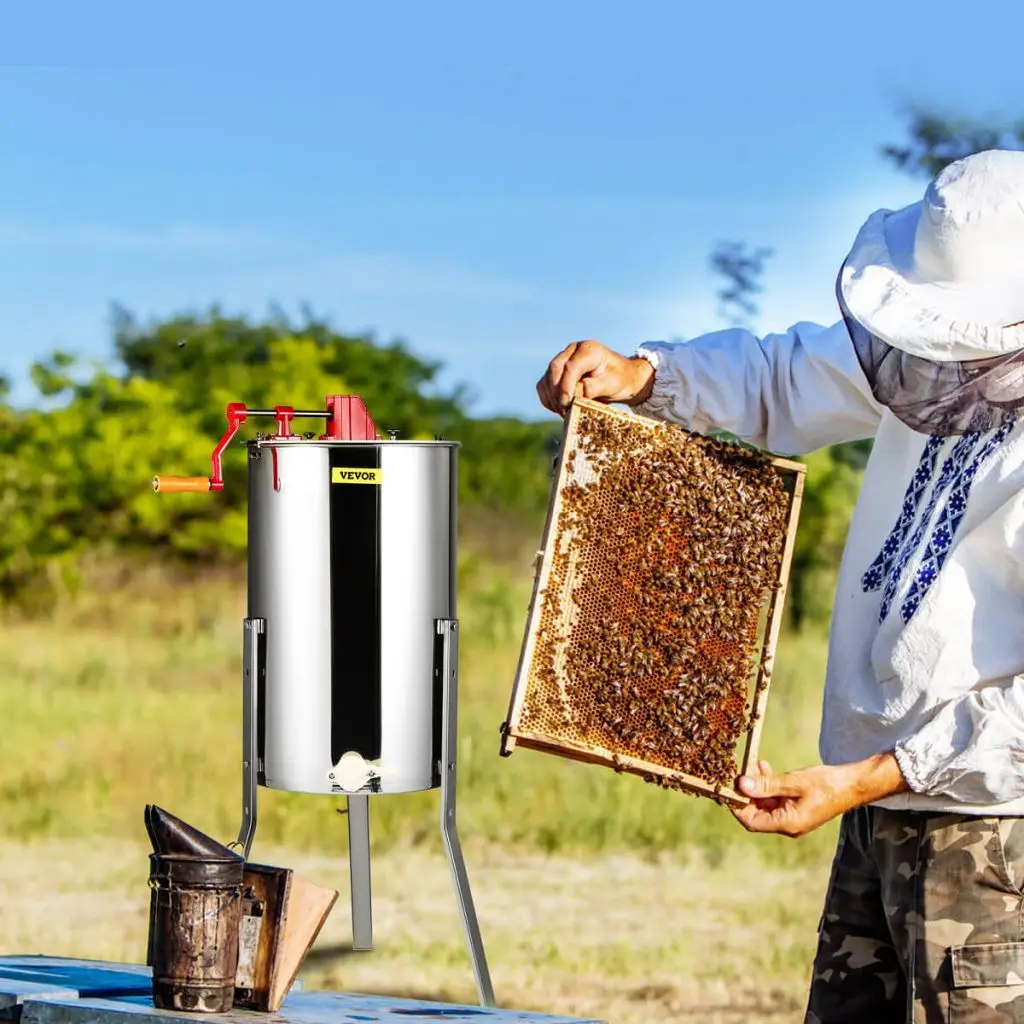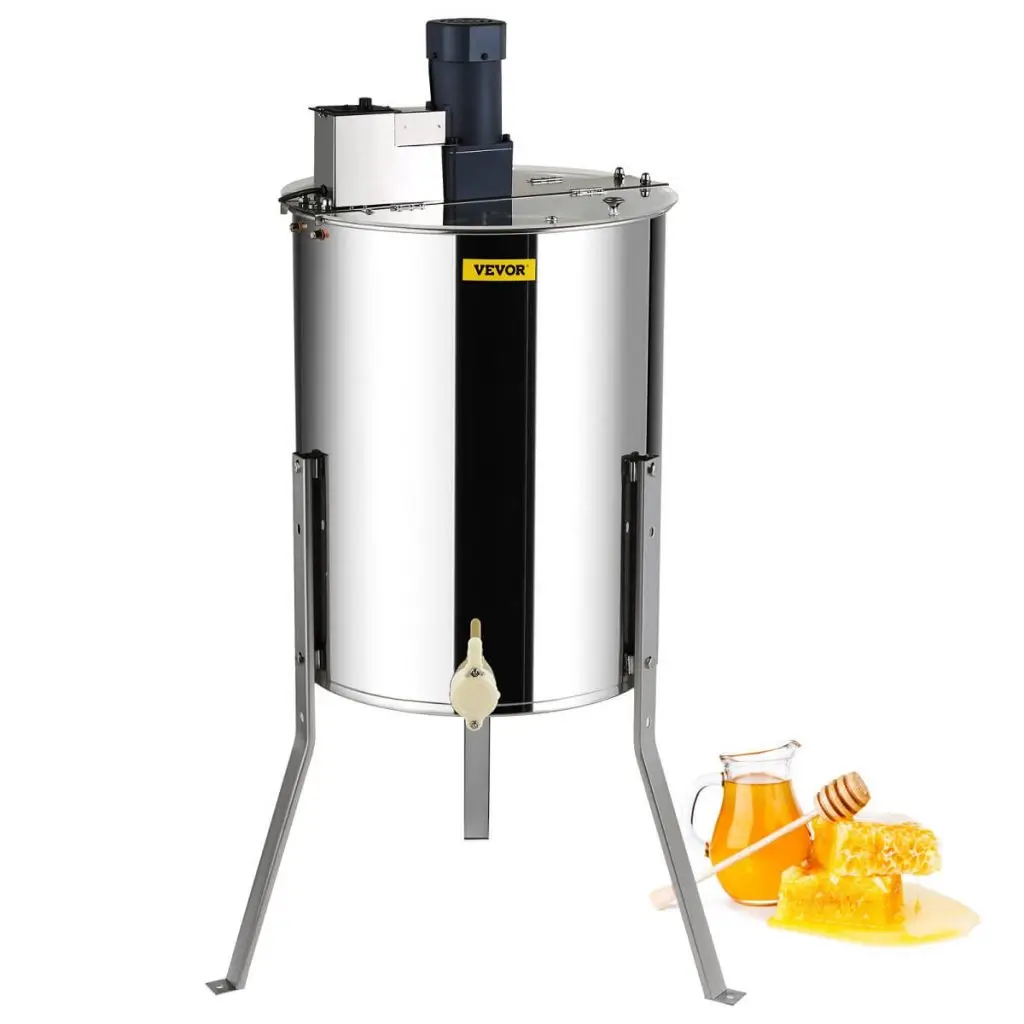There aren’t many things more important to you as a beekeeper than finding a reliable and affordable way to harvest your golden honey, right? If this is you, then you really need to check out VEVOR’s range of honey extractors. The brand has a product range, including manual and electric options, that caters to hobbyists as well as small-scale beekeeping operations.
Budget-conscious beekeepers will strike gold by investing in a VEVOR honey extractor due to the brand’s focus on affordability without sacrificing quality or durability. In this review, we will uncover the key features, benefits, and considerations to help you decide if a VEVOR honey extractor is the right fit for your apiary.
Table of contents
- What is a Honey Extractor and Why Choose VEVOR?
- Key Features of the VEVOR Honey Extractor
- Pros and Cons of the VEVOR Honey Extractor
- Assembly and Setup Process
- How to Use the VEVOR Honey Extractor Efficiently
- Maintenance and Cleaning
- Customer Reviews on VEVOR Honey Extractors
- Comparison with Other Honey Extractors
What is a Honey Extractor and Why Choose VEVOR?
If you’re new to beekeeping, or perhaps you have plans to take it up, either as a profit-oriented business or a small-scale hobby, then this section is especially for you. What exactly is a honey extractor and what does it do?
Understanding Honey Extractors
A honey extractor is one of the most important tools you’ll need as a beekeeper. They are used to spin honey frames, separating the honey from the wax combs in the process. It sounds really easy but it’s quite a delicate task. Honey frames are always needed in the next extraction, therefore the goal is to extract the honey without destroying the frames. This is why you need the right type of honey extractor and skilled hands to pull this off.
Generally, there are two popular types of honey extractors: manual and electric honey extractors. The primary feature of a manual extractor is a built-in hand crank which you’ll need to spin your frames. With an electric honey extractor, the frames are spun using an electric motor, sometimes activated by just the push of a button.
Why VEVOR Honey Extractors Stand Out
One of the most important details you look out for in a honey extractor is durability. VEVOR’s range of honey extractors are known for this quality and that, amongst others, is why they stand out. They use food-grade stainless steel and offer a wide range of frame capacities, from the compact 2/4-frame manual models to the more versatile VEVOR electric honey extractor 4/8-frame electric models.
Speed is another important detail to look out for. Again, VEVOR’s got you covered in that regard, with a range of honey extractors that offer different speed capacities.
Lastly, affordability and ease of use. As already stated, these two qualities make VEVOR’s range of honey extractors attractive, especially to small-scale apiaries and hobby beekeepers. Check out VEVOR honey extractor reviews for more insights from real users.
Recommended For Your Project
Key Features of the VEVOR Honey Extractor
It is important to consider the features of your selected honey extractor before making a choice. These are some of the features of the VEVOR honey extractors.

VEVOR Manual vs. Electric Honey Extractors
Beekeepers with limited honey production typically prefer manual honey extractors. The same goes for beekeepers who approach the process from a strictly traditional point of view. They are usually more affordable and easier to store than electric models.
However, the qualities electric honey extractor models offer are also worthy of note. With these, you are guaranteed an effortless operation, and you get to save time and effort. The last point is especially true when dealing with larger honey harvests.
Frame Capacity and Speed Control
Frame capacity and speed control are important in honey extractors because of the role they play in facilitating efficiency and ease of extracting honey from frames. VEVOR offers a range of frame capacities to suit your needs.
The 3-frame manual extractor is ideal for small-scale beekeepers, while the 4/8-frame VEVOR electric honey extractor is for apiaries with larger honey productions to process. It has a capacity good enough to hold up to 4 deep frames and 4 medium or shallow frames.
Most importantly, electric models in the range such as the 4/8-frame extractor, have variable speed control features that let you adjust the extraction process. This gives the best possible results with different frame types and honey densities.
Build Quality and Materials
VEVOR honey extractors are made of food-grade stainless steel to guarantee durability, and rust resistance, and make them easy to clean. The essence of using this food-safe material is to protect the purity of your honey and simplify maintenance.
Pros and Cons of the VEVOR Honey Extractor
There are advantages and disadvantages that come with using the VEVOR honey extractor, as with any other product. Here are some of them:
Advantages of the VEVOR Honey Extractor
- Quiet operation: This is one of VEVOR’s most liked qualities. You can work as quietly as possible as VEVOR’s manual and electric models are known for their quiet operation. This makes the honey extraction process less stressful for your bees.
- Efficiency: All the products in the VEVOR honey extractor range are designed to extract honey without damaging the frames. Nothing assures a maximized honey yield better than this.
- Adjustable speed (electric models): Electric models in the VEVOR range are designed to include speed control features that make customized extraction possible for you.
- Ease of use: Both manual and electric models are designed for user-friendliness. You don’t necessarily need years of experience or expertise to be able to use them for the first time.
- Value for money: VEVOR honey extractors, compared to other brands, offer exceptional value. This quality is what makes it a budget-friendly choice for hobbyists and small-scale operations.
Drawbacks to Consider
- Stability concerns: Despite how effective VEVOR can be, some users have previously reported minor stability issues. This issue is commonly associated with manual extractor models. This issue can be solved with proper anchoring methods (more to come on this later).
- Cleaning challenges (electric models): The way the electric models are designed, might require a bit more effort during cleaning. The manual models are more straightforward to clean.
- Frame balancing: As with all extractors, proper frame balancing will help you avoid wobbling and damage.
Assembly and Setup Process
The next part of this guide will help you assemble and set up your honey extractor. Here are the step-by-step tips to guide you:
Step-by-Step Assembly Guide
Generally, VEVOR extractors are not difficult to assemble, especially the electric models. You don’t need to be an expert to be able to set them up because each product comes with clear and concise instruction manuals to guide you through the process. Most of the components come pre-assembled, and those parts that don’t fall into this category can be easily connected using tools and instructions that have already been provided.
Here are some practical steps:
- Anchor the extractor’s legs to a base made of plywood to prevent wobbling. This is important for a safe and efficient extraction process.
- You need a level surface to position the extractor. Without this, even weight distribution might be a bit difficult. Also, the height of your extractor matters so you might have to adjust it to a comfortable working height.
- Also, Make sure all screws and bolts are tightened securely.
How to Use the VEVOR Honey Extractor Efficiently

The VEVOR honey extractors are easy to use, but in order to utilize them effectively, there are some things you need to know.
Preparing for Extraction
We’ve emphasized throughout this guide so far just how important balance is to the extraction process. Before you begin, make sure the frames are properly balanced to prevent uneven spinning.
If you use an electric model, set the desired speed based on the density of your honey and the frame type. Place your container under the honey gate to collect the extracted honey.
Safe and Efficient Honey Extraction
Whatever you do, remember you need to extract the honey without damaging the frames. You need to maintain an optimal extraction speed to ensure this is the case. Over-spinning can cause wax damage and honey contamination, so avoid those as well. After each use, clean the extractor thoroughly and apply food-grade lubricant to moving parts to ensure longevity and smooth operation.
Maintenance and Cleaning
By now, you know you have to clean your honey extractor thoroughly after each use, but how? Let’s show you.
How to Clean Your Honey Extractor
Cleaning your VEVOR honey extractor is important if you want to lengthen its lifespan and maintain performance and hygiene.
For electric models, detach the motor and clean it separately. Use warm water and a mild detergent to remove any honey residue. Rinse thoroughly and dry properly to prevent rust and mold. Pay extra attention to the honey gate and legs, they can accumulate sticky residue, and, trust us, that’s not good news for your equipment.
Maintenance Tips for Long-Term Use
To help your VEVOR honey extractor function for an extended period at optimal levels, perform regular checks for loose screws and bolts. Tighten them as needed. Additionally, reapply food-grade lubricant to moving parts, such as the spindle and bearings. Remember, food-grade lubricant ONLY. Follow these simple maintenance tips and you can enjoy years of reliable service from your VEVOR extractor.
Customer Reviews on VEVOR Honey Extractors
Let’s look into what customers are saying about VEVOR honey extractors:
What Customers Love About VEVOR Honey Extractors
Many customers commend VEVOR honey extractors for their user-friendly design, efficient operation, and affordable price. They often point out how easy it is to use the products, the ease of assembly and cleaning, which all combine to make the extraction process hassle-free.
Additionally, customers enjoy the durable stainless steel used in construction and the adjustable speed control feature found on VEVOR’s electric models.
Common Customer Concerns
While VEVOR honey extractors are generally well-received, they’re by no means perfect. Some customers have reported minor stability issues, particularly with the manual models. The recommended solution to this, is to anchor the extractor to a sturdy surface. Additionally, make use of proper frame balancing to prevent wobbling and ensure your extraction is hassle-free.
Comparison with Other Honey Extractors
VEVOR honey extractors are competitive in pricing without losing sight of quality levels. Compared to brands like Maxant and Goodland Bee Supply, VEVOR has superior features and performance at a more affordable price point.
VEVOR vs. Competitors
For example, the Maxant honey extractor is priced at $145.99 and Goodland Bee Supply extractor is priced at $175. While both are 2-frame manual extractor models, VEVOR’s 2/4 frame manual model with superior features is priced at $159.99.
Also, Goodland Bee Supply 2-frame electric model goes for $375.00, Maxant’s super large 6/3 frame extractor is priced at $2,350.00 and suitable for industrial-scale beekeeping while VEVOR’s 4-8 frame electric model is only $289.99.
This makes perfect sense as to why VEVOR is an excellent choice for budget-conscious and small-time beekeepers who just want a reliable and efficient honey extractor to keep things moving.
Conclusion: Is the VEVOR Honey Extractor Right for You?
This guide must have given you some pointers on what to look out for in an effective honey extractor. If you’re a hobbyist or small-scale beekeeper seeking a reliable and affordable honey extractor, VEVOR’s range offers an excellent solution.
You can read more VEVOR honey extractor reviews to see what others are saying about it. With their user-friendly design, durable construction, and efficient operation, a VEVOR honey extractor can simplify your honey harvesting process. Buzzing to start or elevate your beekeeping experience? Check out VEVOR’s honey extractors here to make the right purchase!





